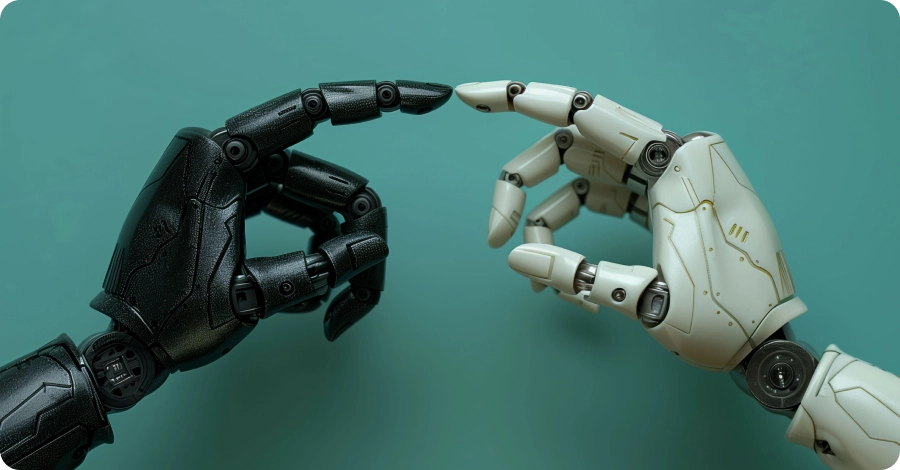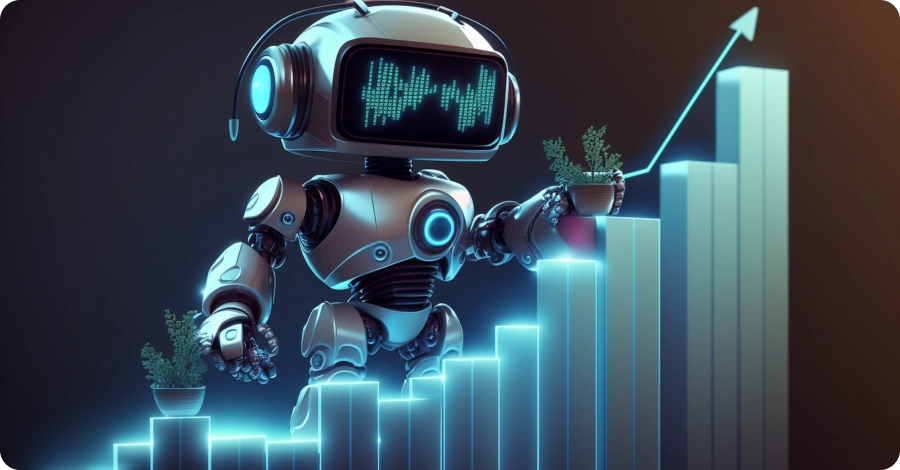AI Agents vs AI Assistants: A Detailed Comparison
- February 13, 2025
- 10 mins read
- Listen

Table of Content
Consider agents and assistants in real life. Assistants follow your guidelines and instructions in order to complete the work assigned to them, while agents work independently while bringing your preferred results. The example above applies for AI Agents and AI Assistants as well.
Like real-life agents and assistants, AI assistants carry out tasks based on your commands, while AI Agents work autonomously for a goal that you have set for them. While that is the most fundamental difference, these two AI systems have some distinct features that you may need for personal or professional use.
So, let’s take a look into AI Agents vs. AI Assistants, the differences in their features, and when to use either technology.
What is an AI Agent?
An AI Agent is a program that is capable of handling one or more tasks autonomously without human intervention. AI Agents can reason at a high level, make use of their excellent decision-making capabilities, and dynamically learn from any of their solutions created or information gathered.
Furthermore, AI Agents can be created for a specific purpose, such as handling job applications for an HR team or fully automating the online shopping process of an e-commerce website. The potential for AI Agents is endless, as they make use of advanced LLMs to complete any task that is handed to them.
How Does an AI Agent Work?
In short, an AI Agent will go through the following steps when it has to carry out a task:
- Taking Initial Input and Creating a Goal
- Breaking the goal down to multiple tasks to complete
- Collecting all the necessary information
- Completing each task one by one
- Continuously checking outcome after each task checked off through a feedback loop
- Providing the solution to the user
- Making adjustments if needed and storing outcomes for future use.
Hence, once you provide an initial query to an AI Agent like “What is the best comedy movie in the 2000s?” it will gather all the relevant information and your preferences and give you the answer to your question.
To learn more about AI Agents, how they work, and more.
AI Agent Use Cases & Examples
As for use cases, AI Agents can be used for the following tasks:
- Lead Generation and Qualification
- Advanced Customer Support
- Autonomous Shopping Assistance
- Monitoring Networks
- Financial Trading Management
And many more…
Through the use of AI Agents, you can automate any task to its fullest potential and autonomously complete certain actions like shopping, financial trading, and the like. Such use cases provide a pathway for businesses to provide a seamless experience for customers and make their lives easier.
Some examples of AI Agents include REVE Chat for customer service, Tesla Autopilot for automobiles, and OpenAI Operator for general use.
What is an AI Assistant?
AI Assistants is a program that completes tasks based on your input. You provide the prompts to the AI Assistant, and it will give you the outcome based on your query. It’s conversational ability allows AI Assistants to provide solutions based on your prompts.
However, AI Assistants are limited, unlike AI Agents, as they rely more on information available and work within certain rules. So, unless the AI Assistant is updated manually, it will work within its knowledge base and carry out tasks as you give them.
Assistants make use of an AI model like DeepSeek’s or OpenAI’s and carry out their tasks. Think of Siri or Alexa when you are trying to imagine an AI Assistant.
How Does an AI Assistant Work?
An AI Assistant takes your input, retrieves relevant information, and provides a solution based on the AI model it makes use of. Using NLP and LLM, AI Assistants can understand queries and provide solutions in any language.
Here is the step-by-step process of how an AI Assistant works:
- Take input from user
- Understand the input
- Search through knowledge base to retrieve relevant information
- Generate a response
- Send it to the user
- Make changes if the user asks for it.
AI Assistants are more simplified when it comes to their approach to providing a response. If you think about it, they are essentially chatbots with better conversational capabilities.
AI Assistant Use Cases & Examples
As for AI Assistant use cases, it provides a lot of value for tasks like:
- Content Generation and Summarization
- Personalized Recommendations
- Customer Service Through AI Chatbots
- Code Generation
- Scheduling Appointments
And many more…
Using AI Assistants, you can command them to schedule a doctor’s appointment, asking for product recommendations, generating a code for you, ordering regular groceries, etc.
AI meeting assistants can also help streamline scheduling and organization, making it easier to manage appointments and tasks efficiently. Examples of AI Assistants include Amazon’s Alexa, Apple’s Siri, OpenAI ChatGPT, and more.
The Differences Between AI Agents and AI Assistants
As both technologies operate differently, there are some key differences between the two. Here is a full feature-by-feature comparison.
| AI Agents | AI Assistants | |
| Function | Performs tasks autonomously | Carries out tasks based on user query |
| Use | Automating a set of tasks to increase efficiency | Assisting users to complete tasks |
| Autonomy | Proactive | Reactive |
| Interactions | Usually operates in the background | Needs user input |
| Decision Making | Advanced decision-making capabilities | Based on pre-defined rules |
| Learning Ability | Can learn from any scenario and adapt accordingly | Learns only for specific scenario |
| Ability To Handle Tasks | Handles complex and multi-step tasks | Executes simple tasks and queries |
| Examples | OpenAI Operator, Tesla Autopilot, REVE Chat | Siri, Alexa, Cortana |
The table above highlights the key differences in how an AI Agent and Assistant operate. Let’s talk about that in detail.
Function
Both AI solutions complete tasks for the users but go about it in a different way. AI Agents work more independently and autonomously without the need of much input, while AI Assistants only work based on user input. The difference here is that one is autonomous and the other is not.
Let’s say you ask an AI Agent and Assistant to suggest live chat software for your business. The assistant would name a bunch of them, like REVE Chat, Intercom, Freshdesk, etc. While the agent would automatically collect all information regarding relevant software and your business to suggest a solution that fits your company.
Autonomy
The difference in terms of autonomy is that AI Agents can operate independently while AI Assistants can’t.
If you ask both an AI Agent and Assistant to buy you a tent:
The AI Assistant would buy a tent. It will not check multiple options, price, etc. This is because you only asked for a tent; you did not ask for a specific type or price range.
The AI Agent will search the web for tents, check your personal information, buy a tent of the right price, and based on your preferences it has gathered, it will order you a tent of your liking.
The difference is clear in the example above: AI Agents provide a more complete solution while operating autonomously, while AI Assistants just do exactly what you asked them to do. Agents need no real specifics, while assistants do.
Use
AI Agents are used to automate certain tasks or objectives, like completely automating the buying process of an e-commerce store. On the other hand, AI Assistants are used to simplify tasks like summarizing an entire document for financial analysis.
Also, AI Assistants can offer more general-purpose solutions, while AI Agents are more specialized in that regard.
Interactions
After the initial input, AI Agents do not need to interact with the user unless more information is required that it cannot find anywhere. AI Assistants constantly require some form of input, as without an input, it will not function at all.
AI Agents will function as long as their goal is defined, while AI Assistants need that query to help the user with what they need.
Decision Making
AI Agents are capable of making complex and in-depth decisions through the power of advanced LLM and a deep knowledge base. Also, it can search internal and external sources to find the information it needs.
Through it’s feedback and task creation loop, AI Agents are capable of thinking and reasoning to create the desired solution for a user. However, AI Assistants are very different in this regard. AI Assistants actually do not make many decisions as they operate within a set of rules.
It will create a solution and function based on the rules it has been configured with. This means their knowledge is limited, and it is not reasoning to see if it’s solution is right or not.
Learning Ability
AI Agents have the ability to learn from different scenarios they face and from solutions they have provided in the past. This makes AI Agents an evolving solution that will constantly get better over time.
AI Assistants have limited learning ability. What it learns is how to communicate with a user and provide some personalized responses and solutions. However, it is only limited to just that in terms of learning. To further train it’s knowledge base or operational approach, the model itself will have to be updated manually.
Task Complexity
AI Agents are capable of completing complex tasks and work that may need multiple steps to complete. It’s advanced decision-making and reasoning capabilities allow AI Agents to handle the more complex tasks with ease.
AI Assistants struggle to do complex tasks and excel more in simple queries. You can fine-tune an AI Assistant to do more specific tasks, but the complexity it can handle can never go over a certain threshold.
Where to Use AI Agent & AI Assistant
Having talked about their differences, you can now get a picture of when to use AI Agents or Assistants. Hence, let’s talk about where you can use AI Agents and AI Assistants.
Where to Use AI Agents?
AI Agents are great when you need tasks to be completed autonomously with no human intervention. Hence, AI Agents are more suited for businesses as they can complete the following types of tasks:
- Providing Great Customer Service for All Businesses
- Fraud Detection and Prevention for BFSI Companies
- Autonomous Shopping Assistance for E-Commerce Businesses
- Network Monitoring and Modeling for Telecom Businesses
- Automated Appointment and Medicine Recommendations for Healthcare Industry
- Smart Navigation System for the Automobile Industry
While most of the tasks we have listed are for businesses, that is where AI Agents excel. You can still use AI Agents for personal use, but they are more suited for businesses.
Where to Use AI Assistants?
AI Assistants are a great tool for doing certain tasks. Here are a few of them:
- Financial Analysis
- Personalized Recommendations
- Content Generation and Summarization
- Simple Task Automation
- Code Generation
Thus, AI assistance can provide a lot of value, but most of it is for personal use. However, you can make use of assistants for simple tasks like helping generate code and such. But they are not the best at it.
All the use cases that AI Assistants fulfill are most suited for personal use, as platforms like ChatGPT and DeepSeek have shown.
In Conclusion
AI Agents and AI Assistants are where the tech world is heading. Both products are trending and will become more prevalent as time passes. As we said earlier, both have their distinct uses, and the comparison shows that both are great for usage.
In short, AI Assistants are better for simple general-purpose queries, while AI Agents can handle complex tasks automatically. Agents are great for automating tasks and completing difficult tasks with ease, while assistants are more suited for simple tasks that will help reduce the workload.
So, if you require AI for personal use, AI Assistants are what you need. While AI Agents are more suited for tasks regarding a business, internally or externally. Hence, both products are suited for different types of tasks, and you should use either when you need to.
Frequently Asked Questions
An AI Agent is a program that can complete tasks automatically, while an AI Assistant requires user input to function. Thus, AI Agent can work independently while AI Assistant cannot.
OpenAI Operator, Tesla Autopilot, and REVE Chat are examples of AI Agents in different industries.
Amazon’s Alexa, Apple’s Siri, and OpenAI’s ChatGPT are examples of AI Assistants.
AI Agents are better for businesses as they can fully automate internal and external tasks like job application sorting, customer service, and such.



